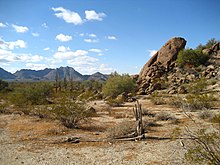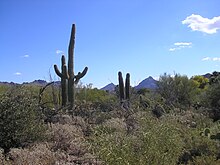Sonoran Desert: Difference between revisions
m Reverted edits by 174.17.1.193 (talk) to last version by Bradjamesbrown |
Doug Dolde (talk | contribs) |
||
| Line 66: | Line 66: | ||
*[http://www.cas.vanderbilt.edu/bioimages/ecoregions/51310frame.htm Sonoran Desert images at bioimages.vanderbilt.edu] ([http://www.cas.vanderbilt.edu/bioimages/ecoregions/51310.htm slow modem version]) |
*[http://www.cas.vanderbilt.edu/bioimages/ecoregions/51310frame.htm Sonoran Desert images at bioimages.vanderbilt.edu] ([http://www.cas.vanderbilt.edu/bioimages/ecoregions/51310.htm slow modem version]) |
||
*[http://www.isdanet.org International Sonoran Desert Alliance] |
*[http://www.isdanet.org International Sonoran Desert Alliance] |
||
*[http://douglasdolde.com/arizona.html Photographs of the Sonoran Desert] |
|||
===Links to parks and recreational areas within the Sonoran Desert=== |
===Links to parks and recreational areas within the Sonoran Desert=== |
||
Revision as of 20:59, 25 April 2010


The Sonoran Desert is a North American desert which straddles part of the United States-Mexico border and covers large parts of the U.S. states of Arizona and California and the northwest Mexican states of Sonora, Baja California, and Baja California Sur. It is one of the largest and hottest deserts in North America, with an area of 311,000 square kilometres (120,000 sq mi). The desert contains a variety of unique plants and animals, such as the saguaro cactus. (The northern part is sometimes called the Gila Desert [citation needed] after the Gila River or the Low Desert in opposition to the higher Mojave Desert).
Location
The Sonoran Desert wraps around the northern end of the Gulf of California, from Baja California Sur-(El Vizcaíno Biosphere Reserve in central and Pacific west coast, Central Gulf Coast subregion on east to southern tip), north through much of Baja California, excluding the central northwest mountains and Pacific west coast, through southeastern California and southwestern and southern Arizona to western and central parts of Sonora. It is bounded on the west by the Peninsular Ranges, which separate it from the California chaparral and woodlands-(northwest), and Baja California desert-(Vizcaino subregion, central and southeast), ecoregions of the Pacific slope. To the north in California and northwest Arizona, the Sonoran Desert transitions to the colder-winter, slightly higher elevation Mojave, Great Basin, and Colorado Plateau deserts. To the east and southeast, the deserts transition to the coniferous Arizona Mountains forests and Sierra Madre Occidental forests at higher elevations. The Sonoran-Sinaloan transition subtropical dry forest marks the transition from the Sonoran Desert to the tropical dry forests of Sinaloa to the south.
The desert's sub-regions include the Colorado Desert of southeastern California and the Yuma Desert east of the north-south Colorado River. In the 1957 publication, Vegetation of the Sonoran Desert, Forrest Shreve divided the Sonoran Desert into seven regions according to characteristic vegetation: Lower Colorado Valley, Arizona Upland, Plains of Sonora, Foothills of Sonora, Central Gulf Coast, Vizcaíno Region, and Magdalena Region. (see An Overview of the Sonoran Desert, external link below). Many ecologists now consider Shreve's Vizcaíno and Magdalena regions, which lie on the western side of the Baja California Peninsula, to be a separate ecoregion, the Baja California desert.
Within the Sonora desert is found the Pinacate National Park, extending 2,000 sq. kilometers of desert and mountainous regions.[1] The Pinacate National Park is home to some of North America's only sand dunes. The nearest city to the Pinacate National Park is Puerto Penasco (also known as Rocky Point).

Ecology
The Sonoran Desert includes 60 mammal species, 350 bird species, 20 amphibian species, 100+ reptile species, 30 native fish species, over 1000 native bee species, and more than 2000 native plant species. The Sonoran Desert area southwest of Tucson and near the Mexican border is vital habitat for the only population of Jaguars living within the United States.
Flora
Many plants not only survive the harsh conditions of the Sonoran Desert, but actually thrive. Many have evolved to have specialized adaptations to the desert climate. The Sonoran Desert's biseasonal rainfall pattern results in more plant species than in the other North America deserts. The Sonoran Desert includes such plants from the agave family, palm family, cactus family, legume family, and many others.

The Sonoran is the only place in the world where the famous saguaro cactus grows in the wild. Cholla, beavertail, hedgehog, fishhook, prickly pear, night blooming cereus, and organ pipe are other species of cactus found here. Cactus provide food and homes to many desert mammals and birds, with showy flowers in reds, pinks, yellows, and whites blooming most commonly from late March through June, depending on the species and seasonal temperatures.
Creosote bush and bur sage dominate valley floors. Indigo bush, Mormon tea, and mesquite are other shrubs that may be found. Wildflowers include desert sand verbena, desert sunflower, and evening primroses. Ascending from the valley up bajadas, various subtrees such as palo verde, ironwood, desert willow, and crucifixion thorn are common, as well as multi-stemmed ocotillo. Shrubs found at higher elevations include whitethorn acacia, fairy duster, and jojoba. In the desert subdivisions found on Baja California, cardon cactus, elephant tree, and boojum tree occur.[2] The California Fan Palm is also found in parts of the Sonoran Desert, including areas of the Anza Borrego Desert State Park.[3]
Human population
The Sonoran Desert is home to seventeen aboriginal American cultures[citation needed].
The largest city in the Sonoran Desert is Phoenix, Arizona, with a 2008 metropolitan population of about 4.3 million.[4] Located on the Salt River in central Arizona, it is one of the fastest-growing metropolitan areas in the United States. In the Phoenix area, desert is losing ground to urban sprawl at a rate of approximately 4,000 square metres (0.99 acres) per hour.[5]
The next largest cities are Tucson, in southern Arizona, with a metro area population of around 1 million,[4] and Mexicali, Baja California, whose municipality also has a population of around 900,000. The municipality of Hermosillo, Sonora, has a population of around 700,000. Ciudad Obregon, Sonora, in the southern part of the desert has a population of 375,800.[6][7]
Conservation
On January 17, 2001, 2,008 square kilometres (496,000 acres) of the Sonoran Desert in Arizona was set aside as the Sonoran Desert National Monument for the purpose of enhancing resource protection.[8]
References
This article needs additional citations for verification. (October 2007) |
- ^ http://www.bajaquest.com/penasco/pinacate.htm
- ^ James A MacMahon, Deserts, 1986, 638 pages
- ^ C. Michael Hogan. 2009. California Fan Palm: Washingtonia filifera, GlobalTwitcher.com, ed. Nicklas Stromberg
- ^ a b Table 1: Annual Estimates of the Population of Metropolitan and Micropolitan Statistical Areas: April 1, 2000 to July 1, 2006 (CBSA-EST2006-01), United States Census Bureau, 2007-04-05. Accessed 2007-09-11
- ^ Make No Small Plans, Adelheid Fischer, ASU Research magazine. Accessed on line October 15, 2007
- ^ Principales resultados por localidad 2005, Instituto Nacional de Estadística Geografía e Informática (Mexico). Accessed on line October 15, 2007
- ^ Population Projections, state government of Baja California, Mexico. Accessed on line October 15, 2007
- ^ Sonoran Desert National Monument, Bureau of Land Management, U. S. Department of the Interior. Accessed on line June 17, 2009.
See also
- List of deserts by area
- List of plants by common name (Sonoran Desert)
- Communities in the Sonoran Desert
- Fauna of the Sonoran Desert
- Mountain Ranges of the Sonoran Desert
- Sonoran Desert National Monument
- Spanish missions in the Sonoran Desert
- List of Sonoran Desert birds (Arizona)
- Yuma Desert
- Chihuahuan Desert
- Mojave Desert
- List of ecoregions in the United States (WWF)
External links
- Sonoran Desert and its subdivisions, with map and photos
- Timeline of the Sonoran desert
- An Overview of the Sonoran Desert, by William G. McGinnies
- The Sonoran Desert Naturalist
- Very short overview of Sonoran Desert Geology
- Map of the Sonoran Desert
- Sonoran desert (World Wildlife Fund)
- Sonoran Desert images at bioimages.vanderbilt.edu (slow modem version)
- International Sonoran Desert Alliance
- Photographs of the Sonoran Desert




